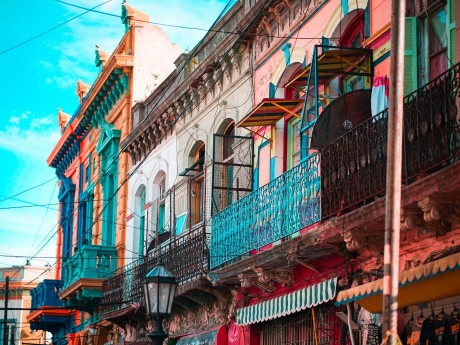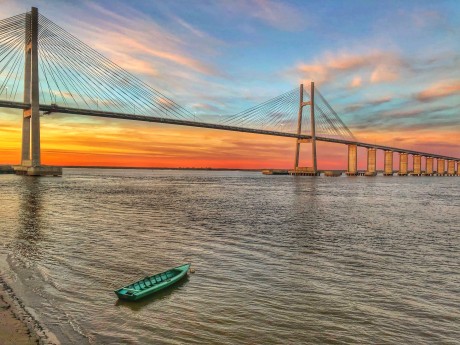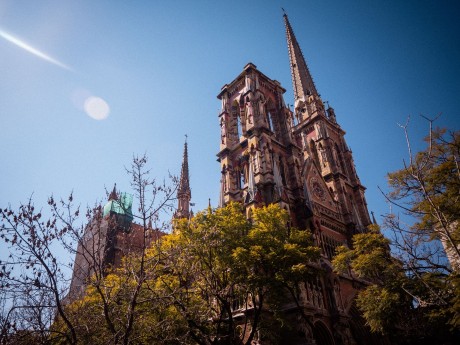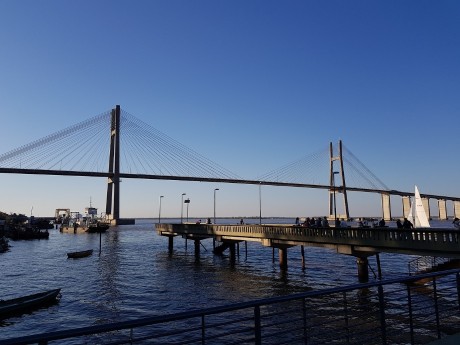Argentina: Buenos Aires, Rosario & Cordoba
Embark on an extraordinary adventure through Argentina, exploring its vibrant cities and diverse landscapes. In Buenos Aires, the captivating capital known for its European charm and passionate tango culture, immerse yourself in the bustling streets of La Boca, visit the iconic Plaza de Mayo, and witness a spectacular tango performance in one of the city's renowned milongas. Next, venture to Rosario, a city steeped in history and located along the scenic banks of the Paraná River.
Read more
Embark on an extraordinary adventure through Argentina, exploring its vibrant cities and diverse landscapes. In Buenos Aires, the captivating capital known for its European charm and passionate tango culture, immerse yourself in the bustling streets of La Boca, visit the iconic Plaza de Mayo, and witness a spectacular tango performance in one of the city's renowned milongas. Next, venture to Rosario, a city steeped in history and located along the scenic banks of the Paraná River. Marvel at the impressive National Flag Memorial, dedicated to the creation of the Argentine flag, and stroll along the picturesque waterfront promenade. Don't miss the opportunity to visit the birthplace of Argentina's beloved football legend, Lionel Messi. Continue your exploration to Cordoba, a city nestled in the heart of the country and surrounded by breathtaking natural landscapes. Discover the UNESCO-listed Jesuit Block, a historic site featuring stunning colonial buildings and the impressive Cordoba Cathedral. Explore the vibrant student district of Güemes, filled with trendy shops, cafes, and art galleries.Waterviews strives to offer accommodation options within walking distance of water and/or in an area of touristic interest. Our prices include taxes (but excludes local tourist taxes). Customize your trip to your personal preferences with optional activities (hit the “Add Activities’’) or change hotels, etc. Contact us for customization at no extra cost at: Service@waterviewstravel.com
Destinations
- Buenos Aires
- Rosario
- Córdoba (city, Argentina)
Itinerary
Buenos Aires

Argentina's evocative capital, Buenos Aires, is a mesmerising blend of culture, history and modernity. Here, skyscrapers contrast with beautiful neoclassical, art nouveau and art deco buildings that house world-class restaurants, traditional cafes and chic bars as well as excellent museums and galleries. Buenos Aires is best known as the world capital of tango, and visitors can find incredible shows and performances on every corner of the city.
Read more
Argentina's evocative capital, Buenos Aires, is a mesmerising blend of culture, history and modernity. Here, skyscrapers contrast with beautiful neoclassical, art nouveau and art deco buildings that house world-class restaurants, traditional cafes and chic bars as well as excellent museums and galleries. Buenos Aires is best known as the world capital of tango, and visitors can find incredible shows and performances on every corner of the city.
Additional Information
Buenos Aires means fair winds, or literally good airs, in Spanish. The official name is Ciudad Autónoma de Buenos Aires ("Autonomous City of Buenos Aires"), also called Capital Federal ("Federal Capital"). It is one of the largest cities in Latin America, with many cultural offerings, and is the point of departure for traveling to the rest of the country. People from Buenos Aires are called porteños, meaning "people from the port" as Buenos Aires was founded as a port city to fend off pirates and other enemies. Buenos Aires is an open and welcoming destination that allows the traveller not only to visit the city but also have an exceptional urban adventure.
The city is geographically contained inside the province of Buenos Aires but is autonomous politically.
The city extends across a plain covering from north to south and from east to west.
About three million people live in the City of Buenos Aires (the Federal Capital of Argentina with . The City is divided into 48 districts or barrios (neighbourhoods). Together with its metropolitan area called Great Buenos Aires (Gran Buenos Aires), it is in the top 30 of most populated urban conurbations in the world with over 15 million people. The majority of Argentina's economic activity is concentrated in this single city and its surroundings.
Buenos Aires always receives tourists from all over the world and offers a wide choice of cultural events, nightlife, restaurants and bars, for which you can expect good service.
Buenos Aires has one of Latin America's biggest LGBT communities. There is a receptive attitude towards LGBT culture in the city. Same-sex marriages are legally performed and recognized in Argentina. There are many LGBT oriented businesses based in the city which extend to the tourism industry. For example, there are travel agents, various classes and nightlife events as well as accommodation catered to LGBT travellers. There are gay cruise ships and even a gay five-star hotel.
Climate
Buenos Aires enjoys a temperate climate with 4 distinct seasons. Because it is located near the coast, extreme heat and cold are rare and the weather allows the city to be visited throughout the year. Winters are cold though frosts are rare. Though daytime temperatures are mild, nights are much colder. It is necessary to wear a coat. Dull, foggy and damp weather characterize winters in Buenos Aires although there is the occasional warm day. At the end of winter, heavy storms are common and it is popularly known at the Santa Rosa Storm which marks the beginning of Spring. Spring and fall are changeable weather with heat waves pushing temperatures up to 38°C (100°F) and cold, polar air masses pushing temperatures down to -4°C (25°F). Even in November, temperatures can drop down to 2°C (36°F). Summers are hot and humid with heavy thunderstorms. It is the sunniest and least cloudiest season. Heat waves can bring periods of muggy weather with high humidity, making it uncomfortable. However, these heat waves do not last for long and cold fronts bring thunderstorms followed by cooler temperatures and lower humidity, bringing relief from the heat.
Talk
The Spanish in Buenos Aires is pronounced differently from most of the Spanish-speaking world. Most conspicuously, the ll sound as in "calle" and "pollo" sounds like English sh. The difference in pronunciation probably reflects the influence of Italian traders in the port in the 19th century—many of the words that Porteños pronounce differently from the rest of the Spanish-speaking world are pronounced identically to an Italian word for the same thing.
Much has been written on the Spanish language in Buenos Aires. It was influenced by the many nationalities that immigrated here, especially Southern Italians.
If you have studied Spanish, you will find these differences enormous. Also, vocabulary differs greatly from Iberian Spanish and other Latin American varieties of Spanish. So it may be useful to get an Argentinian dictionary or take some lessons in Argentinian Spanish before getting to Buenos Aires. Despite these differences, any person who is fluent in Spanish should not have difficulty navigating through conversations with Porteños or other Argentinians. Anyway, most "Porteños" (inhabitants of Buenos Aires City) speak a little English but it is very easy to find people who are very fluent, particularly if you stay around the tourist friendly areas.
© Sourced from Wikivoyage
Rosario

Set on the banks of the Paraná River in Argentina’s Santa Fe region, Rosario is a bustling and down to earth city that has a lot to offer. The city is home to a beautiful collection of art nouveau architecture, and also offers an array of cultural highlights such as museums and galleries. In the summer months you can enjoy Rosario’s lovely river beaches, and by night, soak up the vibrant atmosphere in its excellent restaurants and lively bars.
Read more
Set on the banks of the Paraná River in Argentina’s Santa Fe region, Rosario is a bustling and down to earth city that has a lot to offer. The city is home to a beautiful collection of art nouveau architecture, and also offers an array of cultural highlights such as museums and galleries. In the summer months you can enjoy Rosario’s lovely river beaches, and by night, soak up the vibrant atmosphere in its excellent restaurants and lively bars.
Additional Information
The third most populated city of the country, Rosario is gradually becoming a tourism destination. The attractive city center has some of the finest art nouveau buildings in Argentina. Also, Rosario has developed a good skyline in the area near the river. There are lots of beautiful parks, good riverside beaches for the hot summer days, and many museums.
Rosario has a reputation for being one the most liberal and tolerant cities of the country. It has a vibrant LGBT scene and is governed by socialist mayors since the 1980s.
Being located at a major drug-trafficking route, Rosario has a somewhat bad reputation for being a hub of crime - one of the nicknames is Little Chicago - but tourists normally won't get affected, as the problematic neighborhoods are well outside of the city center and the interesting areas for tourists are not more dangerous than in Buenos Aires or Córdoba.
Weather
Rosario has a temperate climate, and is known for changeable weather conditions. The average annual high is 23.4°C (74.1°F) and the low is 11.6°C (52.9°F). The annual rainfall is 1,038 mm (40.9 in). Summers are hot and humid with thunderstorms that can bring a lot of precipitation. However, sunny days are common. Spring and fall have pleasant weather, featuring warm days and cool nights. Winters are generally cool though occasional cold air masses from the south can cause temperatures to drop below freezing. However, sunny weather and warm days can also occur during winters.
© Sourced from Wikivoyage
Córdoba (city, Argentina)

Best known for its impressive collection of colonial-era architecture, the city of Córdoba is a mesmerising blend of old and new. You can’t miss the city’s historical centre and its magnificent churches, charming squares, neo-baroque Cathedral and the 17th century Jesuit Block and its old university buildings. Córdoba is also a student city, and boasts a vibrant nightlife and cultural scene with countless bars, restaurants and clubs as well as excellent museums and galleries.
Read more
Best known for its impressive collection of colonial-era architecture, the city of Córdoba is a mesmerising blend of old and new. You can’t miss the city’s historical centre and its magnificent churches, charming squares, neo-baroque Cathedral and the 17th century Jesuit Block and its old university buildings. Córdoba is also a student city, and boasts a vibrant nightlife and cultural scene with countless bars, restaurants and clubs as well as excellent museums and galleries.
Additional Information
Córdoba is known by many as La Docta because of its many universities and science institutes. Around 200,000 people study here, which makes the city's population one of the youngest and liveliest in South America. There is much cultural and night life, primarily in the downtown area (centro) and the neighborhoods of Güemes, Nueva Córdoba, Cerro de las Rosas and Alta Córdoba.
The colonial architecture of the city center now coexists with many modern buildings. Although the oldest buildings are found in the surroundings of the Plaza San Martín (microcentro), the most pleasant areas are now the Nueva Córdoba district south of the center and the area around the Cañada, a small colonial canal that crosses the city. These areas show a mix of well-designed modern buildings and beautiful old houses, often built in neo-colonial style. The old district Barrio Güemes, where many buildings are protected by municipal laws, is now particularly pleasant, with a 19th-century atmosphere rather similar to Buenos Aires' San Telmo district, but with more life on the streets. It is however, unfortunately for some and fortunately for others, heavily affected by gentrification.
The city district itself covers 529 square km (204 sq mi) and has 1.3 million inhabitants. Population growth of the city itself has slowed down in the past decades, and many people moved to suburbs and satellite towns outside this area. Those west of the city lie in the hills of the Sierras de Córdoba and are residential areas with some tourist attractions (see Go Next). North and east of the city, in the plains, there are poor suburbs with a slum-like appearance like Juárez Celman and Malvinas Argentinas.
Climate
The climate in the city and surrounding areas is pleasant year round. Even in winter there are frequent warm, sunny days, although you must be prepared for cold nights and some chilly, cloudy periods, which never last more than a week or so. During the summer, the rainy season (November to March), it is hot and humid with frequent rain showers and thunderstorms at the afternoon. The rain causes some spot flooding due to an unsatisfactory drainage system. The best time to visit Córdoba is March to May and August to November, when it's not too hot nor too cool and there is little rain.
History
Córdoba was founded in 1573 by Jerónimo Luis de Cabrera. For the first two centuries of its history it was the largest and most important town in the region that today is Argentina, until in 1776 Buenos Aires was declared capital of the Virreinato del Río de la Plata. Córdoba's university was founded as early as 1613 by the Jesuits. The Catholic Church had much influence on social life until 1900, and Córdoba sometimes was called "the Rome of Argentina" being a stronghold for conservativism.
In the 1950s the city was industrialized by the Perón and Frondizi governments. In the following decades Córdoba transformed into Argentina's second technology hub behind Buenos Aires, leading above-all in motor industry (IKA - now Renault -, Volkswagen and Fiat), aviation (the famous Fábrica Militar de Aviones, Argentina's main aircraft producer, is located here) and, later, in high-tech sectors like software and electronics. Also, the second half of the 20th century was marked by explosive population growth due to migration from northern Argentina. In 1980, the metropolitan area, and in the 1991 census the city itself passed the million inhabitants.
Córdoba has played a major role in some of the revolutionary movements in 20th century Argentina. In 1918 a student revolution, the Reforma Universitaria, led to a modernization of what is now the National University, which until this time had been very conservative and elitist. This revolution spread to all cities of Argentina and most of Latin America, leading to more autonomy and openness in the regional educational institutions. In 1955, the conservative Revolución Libertadora led to the resignation of President Juan Perón. In 1969 and 1971, two left-wing riots known as Cordobazo and Viborazo were among the main reasons for the end of the military dictatorship which had governed Argentina since 1966. While in the 2001/02 crisis the city was fairly quiet, an infamous police riot in 2013 led to two nights of violence which spread to other regions of Argentina.
Beginning with the early 1970s, and more strongly after democratization took place in 1983, the formerly very conservative city began to open and evolve into a cosmopolitan regional metropolis. An unique urban popular culture characterized by comedy, theater and the cuarteto music began to appear. At the same time, Córdoba diversified its economy, evolving from a industrial-governmental provincial town to an important hub for commerce, culture, education and services.
© Sourced from Wikivoyage





